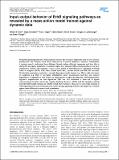Input–output behavior of ErbB signaling pathways as revealed by a mass action model trained against dynamic data
Author(s)
Lauffenburger, Douglas A.; Chen, William W.; Schoeberl, Birgit; Jasper, Paul J.; Nielsen, Ulrik B.; Niepel, Mario; Sorger, Peter K.; ... Show more Show less
DownloadLauffenburger Input-Output msb200874-1.pdf (2.172Mb)
PUBLISHER_POLICY
Publisher Policy
Article is made available in accordance with the publisher's policy and may be subject to US copyright law. Please refer to the publisher's site for terms of use.
Terms of use
Metadata
Show full item recordAbstract
The ErbB signaling pathways, which regulate diverse physiological responses such as cell survival, proliferation and motility, have been subjected to extensive molecular analysis. Nonetheless, it remains poorly understood how different ligands induce different responses and how this is affected by oncogenic mutations. To quantify signal flow through ErbB-activated pathways we have constructed, trained and analyzed a mass action model of immediate-early signaling involving ErbB1–4 receptors (EGFR, HER2/Neu2, ErbB3 and ErbB4), and the MAPK and PI3K/Akt cascades. We find that parameter sensitivity is strongly dependent on the feature (e.g. ERK or Akt activation) or condition (e.g. EGF or heregulin stimulation) under examination and that this context dependence is informative with respect to mechanisms of signal propagation. Modeling predicts log-linear amplification so that significant ERK and Akt activation is observed at ligand concentrations far below the Kd for receptor binding. However, MAPK and Akt modules isolated from the ErbB model continue to exhibit switch-like responses. Thus, key system-wide features of ErbB signaling arise from nonlinear interaction among signaling elements, the properties of which appear quite different in context and in isolation.
Date issued
2009-01Department
Massachusetts Institute of Technology. Department of Biological EngineeringJournal
Molecular Systems Biology
Publisher
Nature Publishing Group
Citation
Chen, William W et al. “Input-output behavior of ErbB signaling pathways as revealed by a mass action model trained against dynamic data.” Mol Syst Biol 5 (2009): p.1-19. © 2010 Nature Publishing Group.
Version: Final published version
ISSN
1744-4292